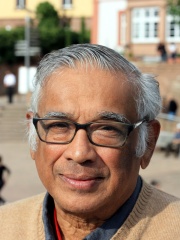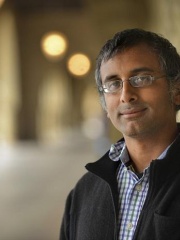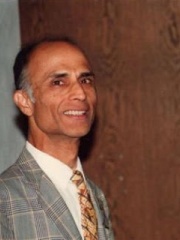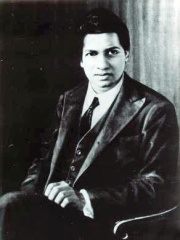
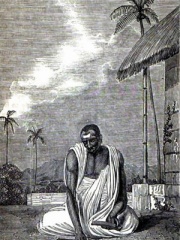

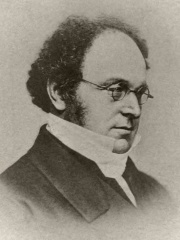
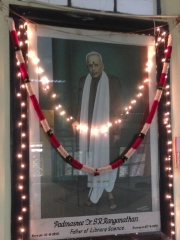


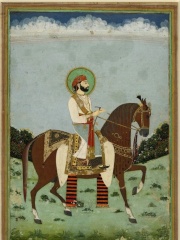
The Most Famous
MATHEMATICIANS from India
This page contains a list of the greatest Indian Mathematicians. The pantheon dataset contains 1,004 Mathematicians, 20 of which were born in India. This makes India the birth place of the 12th most number of Mathematicians behind Switzerland, and China.
Top 10
The following people are considered by Pantheon to be the top 10 most legendary Indian Mathematicians of all time. This list of famous Indian Mathematicians is sorted by HPI (Historical Popularity Index), a metric that aggregates information on a biography's online popularity. Visit the rankings page to view the entire list of Indian Mathematicians.

1. Srinivasa Ramanujan (1887 - 1920)
With an HPI of 79.85, Srinivasa Ramanujan is the most famous Indian Mathematician. His biography has been translated into 96 different languages on wikipedia.
Srinivasa Ramanujan Iyengar (22 December 1887 – 26 April 1920) was an Indian mathematician who worked during the early 20th century. Despite having almost no formal training in pure mathematics, he made substantial contributions to mathematical analysis, number theory, infinite series, and continued fractions, including solutions to mathematical problems then considered unsolvable. Ramanujan initially developed his own mathematical research in isolation. According to Hans Eysenck, "he tried to interest the leading professional mathematicians in his work, but failed for the most part. What he had to show them was too novel, too unfamiliar, and additionally presented in unusual ways; they could not be bothered." Seeking mathematicians who could better understand his work, in 1913 he began a mail correspondence with the English mathematician G. H. Hardy at the University of Cambridge, England. Recognising Ramanujan's work as extraordinary, Hardy arranged for him to travel to Cambridge. In his notes, Hardy commented that Ramanujan had produced groundbreaking new theorems, including some that "defeated me completely; I had never seen anything in the least like them before", and some recently proven but highly advanced results. Throughout his life, Ramanujan independently compiled nearly 3,900 results (mostly identities and equations). Many were completely novel; his original and highly unconventional results, such as the Ramanujan prime, the Ramanujan theta function, partition formulae and mock theta functions, have opened entire new areas of work and inspired further research. Of his thousands of results, most have been proven correct. The Ramanujan Journal, a scientific journal, was established to publish work in all areas of mathematics influenced by Ramanujan, and his notebooks—containing summaries of his published and unpublished results—have been analysed and studied for decades since his death as a source of new mathematical ideas. As late as 2012, researchers continued to discover that mere comments in his writings about "simple properties" and "similar outputs" for certain findings were themselves profound and subtle number theory results that remained unsuspected until nearly a century after his death. He became one of the youngest Fellows of the Royal Society and only the second Indian member, and the first Indian to be elected a Fellow of Trinity College, Cambridge. In 1919, ill health—now believed to have been hepatic amoebiasis (a complication from episodes of dysentery many years previously)—compelled Ramanujan's return to India, where he died in 1920 at the age of 32. His last letters to Hardy, written in January 1920, show that he was still continuing to produce new mathematical ideas and theorems. His "lost notebook", containing discoveries from the last year of his life, caused great excitement among mathematicians when it was rediscovered in 1976.

2. Brahmagupta (598 - 670)
With an HPI of 78.74, Brahmagupta is the 2nd most famous Indian Mathematician. His biography has been translated into 115 different languages.
Brahmagupta (c. 598 – c. 668 CE) was an Indian mathematician and astronomer. He is the author of two early works on mathematics and astronomy: the Brāhmasphuṭasiddhānta (BSS, "correctly established doctrine of Brahma", dated 628), a theoretical treatise, and the Khandakhadyaka ("edible bite", dated 665), a more practical text. He was the first Indian scholar to describe gravity as an attractive force, and used the term "gurutvākarṣaṇam" in Sanskrit to describe it. He is also credited with the first clear description of the quadratic formula (the solution of the quadratic equation) in his main work, the Brāhma-sphuṭa-siddhānta.

3. Bhāskara II (1114 - 1185)
With an HPI of 73.90, Bhāskara II is the 3rd most famous Indian Mathematician. His biography has been translated into 58 different languages.
Bhāskara II ([bʰɑːskərə]; c.1114–1185), also known as Bhāskarāchārya (lit. 'Bhāskara the teacher'), was an Indian polymath, mathematician, and astronomer. From verses in his main work, Siddhānta Śiromaṇi, it can be inferred that he was born in 1114 in Vijjadavida (Vijjalavida) and living in the Satpura mountain ranges of Western Ghats, believed to be the town of Patana in Chalisgaon, located in present-day Khandesh region of Maharashtra by scholars. In a temple in Maharashtra, an inscription, supposedly created by his grandson Changadeva, lists Bhaskaracharya's ancestral lineage for several generations before him as well as two generations after him. Henry Colebrooke who was the first European to translate (1817) Bhaskaracharya's mathematical classics refers to the family as Maharashtrian Brahmins residing on the banks of the Godavari. Born in a Hindu Deshastha Brahmin family of scholars, mathematicians and astronomers, Bhaskara II was the leader of a cosmic observatory at Ujjain, the main mathematical centre of ancient India. Bhāskara and his works represent a significant contribution to mathematical and astronomical knowledge in the 12th century. He has been called the greatest mathematician of medieval India. His main work, Siddhānta-Śiromaṇi (Sanskrit for "Crown of Treatises"), is divided into four parts called Līlāvatī, Bījagaṇita, Grahagaṇita and Golādhyāya, which are also sometimes considered four independent works. These four sections deal with arithmetic, algebra, mathematics of the planets, and spheres respectively. He also wrote another treatise named Karaṇā Kautūhala.

4. Augustus De Morgan (1806 - 1871)
With an HPI of 71.69, Augustus De Morgan is the 4th most famous Indian Mathematician. His biography has been translated into 48 different languages.
Augustus De Morgan (27 June 1806 – 18 March 1871) was a British mathematician and logician. He is best known for De Morgan's laws, relating logical conjunction, disjunction, and negation, and for coining the term "mathematical induction", the underlying principles of which he formalized. De Morgan's contributions to logic are heavily used in many branches of mathematics, including set theory and probability theory, as well as other related fields such as computer science.

5. Madhava of Sangamagrama (1350 - 1425)
With an HPI of 70.93, Madhava of Sangamagrama is the 5th most famous Indian Mathematician. His biography has been translated into 26 different languages.
Mādhava of Sangamagrāma (Mādhavan) (c. 1340 – c. 1425) was an Indian mathematician and astronomer who is considered to be the founder of the Kerala school of astronomy and mathematics in the Late Middle Ages. Madhava made pioneering contributions to the study of infinite series, trigonometry, geometry and algebra. He was the first to use infinite series approximations for a range of trigonometric functions, which has been called the "decisive step onward from the finite procedures of ancient mathematics to treat their limit-passage to infinity".

6. S. R. Ranganathan (1892 - 1972)
With an HPI of 65.18, S. R. Ranganathan is the 6th most famous Indian Mathematician. His biography has been translated into 33 different languages.
Shiyali Ramamrita Ranganathan ( 12 August 1892 – 27 September 1972) was an Indian librarian and mathematician. His most notable contributions to the field were his five laws of library science and the development of the first major faceted classification system, the colon classification. He is considered to be the father of library science, documentation, and information science in India and is widely known throughout the rest of the world for his fundamental thinking in the field. His birthday is observed every year as National Librarian Day in India. He was a university librarian and professor of library science at Banaras Hindu University (1945–47) and professor of library science at the University of Delhi (1947–55), the first Indian school of librarianship to offer higher degrees. He was president of the Indian Library Association from 1944 to 1953. In 1957 he was elected as an honorary member of the International Federation for Information and Documentation (FID) and was made vice-president for life of the Library Association of Great Britain.

7. Bhāskara I (600 - 680)
With an HPI of 62.29, Bhāskara I is the 7th most famous Indian Mathematician. His biography has been translated into 26 different languages.
Bhāskara I (c. 600 – c. 680) was a 7th-century Indian mathematician and astronomer who was the first to write numbers in the Hindu–Arabic decimal system with a circle for the zero, and who gave a unique and remarkable rational approximation of the sine function in his commentary on Aryabhata's work. This commentary, Āryabhaṭīyabhāṣya, written in 629, is among the oldest known prose works in Sanskrit on mathematics and astronomy. He also wrote two astronomical works in the line of Aryabhata's school: the Mahābhāskarīya ("Great Book of Bhāskara") and the Laghubhāskarīya ("Small Book of Bhāskara"). On 7 June 1979, the Indian Space Research Organisation launched the Bhāskara I satellite, named in honour of the mathematician.

8. D. R. Kaprekar (1905 - 1986)
With an HPI of 59.51, D. R. Kaprekar is the 8th most famous Indian Mathematician. His biography has been translated into 27 different languages.
Dattatreya Ramchandra Kaprekar (Marathi: दत्तात्रेय रामचंद्र कापरेकर; 17 January 1905 – 4 July 1986) was an Indian recreational mathematician who described several classes of natural numbers including the Kaprekar, harshad and self numbers and discovered Kaprekar's constant, named after him. Despite having no formal postgraduate training and working as a schoolteacher, he published extensively and became well known in recreational mathematics circles.

9. Jai Singh II (1688 - 1743)
With an HPI of 58.94, Jai Singh II is the 9th most famous Indian Mathematician. His biography has been translated into 17 different languages.
Sawai Jai Singh II (3 November 1688 – 21 September 1743), was the 30th Kachwaha Rajput ruler of the Kingdom of Amber, who later founded the fortified city of Jaipur and made it his capital. He became the ruler of Amber at the age of 11, after the untimely death of his father Mirza Raja Bishan Singh on 31 December 1699. Initially, Raja Jai Singh served as a vassal of the Mughal Empire. He was given the title of "Sawai" by Mughal Emperor Aurangzeb before the siege of Khelna Fort in Deccan."Sawai" means one and a quarter times superior to his contemporaries. He received the title of "Maharaja Sawai, Raj Rajeshwar, Shri Rajadhiraj " in the year 1723 which happened to be the reign of later Mughals under emperor Muhammad Shah; this was in addition to the title of "Saramad-i-Raja-i-Hindustan", conferred on him on 21 April 1721. In the later part of his life Sawai Jai Singh broke free from Mughal hegemony, and to assert his sovereignty, performed the Ashvamedha sacrifice, an ancient rite that had been abandoned for several centuries. He moved his kingdom's capital from the town of Amber to the newly established walled city of Jaipur in 1727 and performed two Ashwamedha sacrifices, one in 1734, and again in 1741. Sawai Jai Singh II other than administration and state craftship had a profound interest in the fields of Mathematics, Architecture, Astronomy, Astrology and Literature. He commissioned the Jantar Mantar observatories at multiple places in India, including his capital Jaipur. He had Euclid's "Elements of Geometry" translated into Sanskrit.

10. Sulochana Gadgil (1944 - 2025)
With an HPI of 58.71, Sulochana Gadgil is the 10th most famous Indian Mathematician. Her biography has been translated into 20 different languages.
Sulochana Gadgil (1944 – 24 July 2025) was an Indian meteorologist who retired as Professor from the Centre for Atmospheric and Oceanic Sciences (CAOS) in Bangalore, India. She studied the how and why of monsoons, including farming strategies to cope with rainfall variability and modelling ecological and evolutionary phenomena. Her research led to the discovery of a basic feature of the sub-seasonal variation in the monsoon cloud bands. She demonstrated that the monsoon is not a gigantic land-sea breeze but instead is a manifestation of the seasonal migration of a planetary-scale system which is seen over non-monsoonal regions as well. In collaboration with the farmers she derived farming strategies which are tailored to the rainfall variability of different regions in India.
People
Pantheon has 20 people classified as Indian mathematicians born between 200 BC and 1981. Of these 20, 3 (15.00%) of them are still alive today. The most famous living Indian mathematicians include S. R. Srinivasa Varadhan, Raman Parimala, and Akshay Venkatesh. The most famous deceased Indian mathematicians include Srinivasa Ramanujan, Brahmagupta, and Bhāskara II.
Living Indian Mathematicians
Go to all RankingsS. R. Srinivasa Varadhan
1940 - Present
HPI: 54.53
Raman Parimala
1948 - Present
HPI: 45.05
Akshay Venkatesh
1981 - Present
HPI: 44.04
Deceased Indian Mathematicians
Go to all RankingsSrinivasa Ramanujan
1887 - 1920
HPI: 79.85
Brahmagupta
598 - 670
HPI: 78.74
Bhāskara II
1114 - 1185
HPI: 73.90
Augustus De Morgan
1806 - 1871
HPI: 71.69
Madhava of Sangamagrama
1350 - 1425
HPI: 70.93
S. R. Ranganathan
1892 - 1972
HPI: 65.18
Bhāskara I
600 - 680
HPI: 62.29
D. R. Kaprekar
1905 - 1986
HPI: 59.51
Jai Singh II
1688 - 1743
HPI: 58.94
Sulochana Gadgil
1944 - 2025
HPI: 58.71
Nilakantha Somayaji
1444 - 1544
HPI: 57.69
Harish-Chandra
1923 - 1983
HPI: 54.31
Overlapping Lives
Which Mathematicians were alive at the same time? This visualization shows the lifespans of the 8 most globally memorable Mathematicians since 1700.

